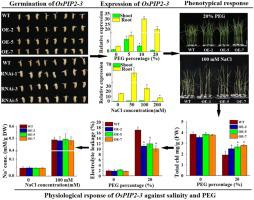当前位置:
X-MOL 学术
›
Environ. Exp. Bot.
›
论文详情
Our official English website, www.x-mol.net, welcomes your
feedback! (Note: you will need to create a separate account there.)
OsPIP2;3 as an aquaporin contributes to rice resistance to water deficit but not to salt stress
Environmental and Experimental Botany ( IF 4.5 ) Pub Date : 2021-03-01 , DOI: 10.1016/j.envexpbot.2020.104342 Jia Yun Sun , Xue Son Liu , Irfan Ullah Khan , Xi Chen Wu , Zhi Min Yang
Environmental and Experimental Botany ( IF 4.5 ) Pub Date : 2021-03-01 , DOI: 10.1016/j.envexpbot.2020.104342 Jia Yun Sun , Xue Son Liu , Irfan Ullah Khan , Xi Chen Wu , Zhi Min Yang

|
Abstract Plant aquaporins are a class of membrane intrinsic channels that predominantly transport water and function in adaptation to drought and salinity stresses. Many aquaporins are reported in a verity of planta, but their biological functions and mechanisms for coordinating water movement are largely unknown. In this study we identified a functionally uncharacterized PIP2 subfamily gene OsPIP2;3 involved in rice water deficit and salt stress responses. OsPIP2;3 was targeted to the plasma membrane and mainly expressed in roots throughout the life span. OsPIP2;3 was substantially upregulated under osmotic and salt stresses. The tolerance of OsPIP2;3 under water deficit was demonstrated in the transgenic rice overexpressing OsPIP2;3 that significantly enhanced the plant growth, with tissue elongation, fresh biomass, and chlorophyll accumulation. The increased adaptation to water deficit was associated with the physiological responses, exhibiting the lower degree of drought-induced cellular damage including electrolyte leakage, reactive oxygen species (O2- and H2O2), peroxides (malondialdehyde), and higher survival rate, water holding capacity and proline accumulation. In contrast, OsPIP2;3 knockdown (RNA interference, RNAi) resulted in the growth retard and physiological defects. Both OsPIP2;3 overexpression (OE) and RNAi lines did not show evident effects on the root and shoot elongation, plant biomass, and Na+ or K+ concentrations in rice under salt stress, implying that OsPIP2;3 is not involved in salt stress response. Collectively, these studies point out that OsPIP2;3 as an aquaporin contributes to the adaptation of rice to water-limiting but not to salinity environment.
中文翻译:

OsPIP2;3 作为水通道蛋白有助于水稻抗缺水但不抗盐胁迫
摘要 植物水通道蛋白是一类主要运输水分并适应干旱和盐分胁迫的膜内在通道。许多水通道蛋白在植物中都有报道,但它们的生物学功能和协调水运动的机制在很大程度上是未知的。在这项研究中,我们鉴定了一个功能未表征的 PIP2 亚家族基因 OsPIP2;3,它与水稻缺水和盐胁迫反应有关。OsPIP2;3 以质膜为目标,在整个生命周期中主要在根中表达。OsPIP2;3 在渗透和盐胁迫下显着上调。OsPIP2;3 在缺水条件下的耐受性在过表达 OsPIP2;3 的转基因水稻中得到证明,其显着增强了植物生长,具有组织伸长、新鲜生物量和叶绿素积累。对缺水的适应增加与生理反应有关,表现出较低程度的干旱引起的细胞损伤,包括电解质泄漏、活性氧(O2-和 H2O2)、过氧化物(丙二醛),以及更高的存活率和持水能力和脯氨酸积累。相比之下,OsPIP2;3 敲低(RNA 干扰,RNAi)导致生长迟缓和生理缺陷。OsPIP2;3 过表达 (OE) 和 RNAi 系对盐胁迫下水稻的根和枝条伸长、植物生物量和 Na+ 或 K+ 浓度均未显示出明显影响,表明 OsPIP2;3 不参与盐胁迫响应。总的来说,这些研究指出 OsPIP2;3 作为一种水通道蛋白有助于水稻适应限水但不适应盐度环境。
更新日期:2021-03-01
中文翻译:

OsPIP2;3 作为水通道蛋白有助于水稻抗缺水但不抗盐胁迫
摘要 植物水通道蛋白是一类主要运输水分并适应干旱和盐分胁迫的膜内在通道。许多水通道蛋白在植物中都有报道,但它们的生物学功能和协调水运动的机制在很大程度上是未知的。在这项研究中,我们鉴定了一个功能未表征的 PIP2 亚家族基因 OsPIP2;3,它与水稻缺水和盐胁迫反应有关。OsPIP2;3 以质膜为目标,在整个生命周期中主要在根中表达。OsPIP2;3 在渗透和盐胁迫下显着上调。OsPIP2;3 在缺水条件下的耐受性在过表达 OsPIP2;3 的转基因水稻中得到证明,其显着增强了植物生长,具有组织伸长、新鲜生物量和叶绿素积累。对缺水的适应增加与生理反应有关,表现出较低程度的干旱引起的细胞损伤,包括电解质泄漏、活性氧(O2-和 H2O2)、过氧化物(丙二醛),以及更高的存活率和持水能力和脯氨酸积累。相比之下,OsPIP2;3 敲低(RNA 干扰,RNAi)导致生长迟缓和生理缺陷。OsPIP2;3 过表达 (OE) 和 RNAi 系对盐胁迫下水稻的根和枝条伸长、植物生物量和 Na+ 或 K+ 浓度均未显示出明显影响,表明 OsPIP2;3 不参与盐胁迫响应。总的来说,这些研究指出 OsPIP2;3 作为一种水通道蛋白有助于水稻适应限水但不适应盐度环境。











































 京公网安备 11010802027423号
京公网安备 11010802027423号